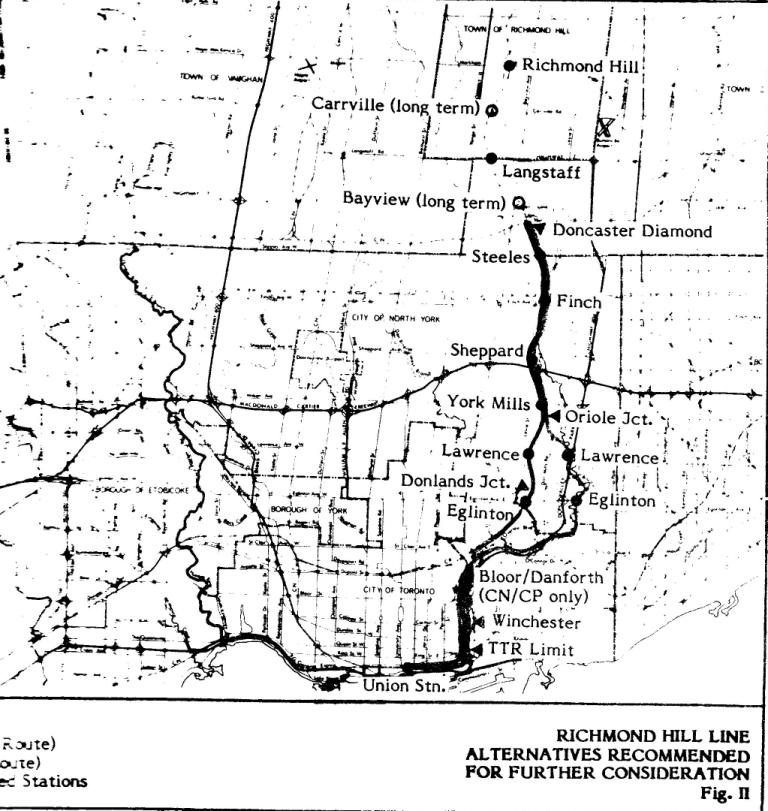Electrify
Senior Member
It will never happen, but I'd say the best thing they could do is build a second express tunnel under Yonge, with spaced out stops to handle excess demand and to ensure longer commutes are more efficient.
It will never happen, but I'd say the best thing they could do is build a second express tunnel under Yonge, with spaced out stops to handle excess demand and to ensure longer commutes are more efficient.
OR... they could simply straighten out and electrify the Bala subdivision permitting EMUs to run between Richmond Hill GO and Union Station with stops en route at Hillcrest (16th), Langstaff (RHC Terminal), Thornhill (Bayview/John), German Mills (Steeles), Old Cummer (Finch), Oriole (Sheppard), Silver Hills (York Mills), Don Mills Ctr (Donway, n. of Lawrence), Wilket Creek via Seaton Sub (Leslie/Eglinton), Leaside (Laird/Millwood), Castle Frank (Bloor-Danforth), West Don Lands (Queen), Distillery (Parliament).
De facto DRL eastern leg on the cheap! Make the fare schema the same as YRT's eliminating the double fares, and we'd witness a dramatic decline in 905 residents boarding the Yonge Line in order to commute to/from workplaces downtown.
OR... they could simply straighten out and electrify the Bala subdivision permitting EMUs to run between Richmond Hill GO and Union Station with stops en route at Hillcrest (16th), Langstaff (RHC Terminal), Thornhill (Bayview/John), German Mills (Steeles), Old Cummer (Finch), Oriole (Sheppard), Silver Hills (York Mills), Don Mills Ctr (Donway, n. of Lawrence), Wilket Creek via Seaton Sub (Leslie/Eglinton), Leaside (Laird/Millwood), Castle Frank (Bloor-Danforth), West Don Lands (Queen), Distillery (Parliament).
De facto DRL eastern leg on the cheap! Make the fare schema the same as YRT's eliminating the double fares, and we'd witness a dramatic decline in 905 residents boarding the Yonge Line in order to commute to/from workplaces downtown.
I was thinking more specifically who live and work along the Yonge corridor within Toronto. Case in point, while the Yonge line is bursting as the seems, the Spadina line offers plenty of extra room in comparison. If people won't travel west to the Spadina line, how can we be sure they will travel east to a Don Mills line?
That would do very little to take 905ers off the Yonge line.
Why should 905ers not use the Yonge line? Anyone living on or near Yonge, whether it be north or south of Steeles, is best suited to use the Yonge subway. The reason why the line is overcrowded is because portions north of Bloor carry much of eastern North York and western Scarborough, while portions south of Bloor serve the entire GTA. At most 10 or 20 thousand poeple from York Region ride the Yonge line all the way downtown each day. They are hardly to blame for the overcrowding on the busiest sections.
Why should 905ers not use the Yonge line? Anyone living on or near Yonge, whether it be north or south of Steeles, is best suited to use the Yonge subway. The reason why the line is overcrowded is because portions north of Bloor carry much of eastern North York and western Scarborough, while portions south of Bloor serve the entire GTA. At most 10 or 20 thousand poeple from York Region ride the Yonge line all the way downtown each day. They are hardly to blame for the overcrowding on the busiest sections.
This is just the latest in a line of your nonsense.
1) Adding that many stops would increase the running time of the line significantly and it would no longer be an express which is what it should be used for: RER.
2) Have you actually looked at those places? Particularly those helpful stations that you suggested putting 150-200 feet below in the Don Valley. Really useful there.

OR... they could simply straighten out and electrify the Bala subdivision permitting EMUs to run between Richmond Hill GO and Union Station with stops en route at Hillcrest (16th), Langstaff (RHC Terminal), Thornhill (Bayview/John), German Mills (Steeles), Old Cummer (Finch), Oriole (Sheppard), Silver Hills (York Mills), Don Mills Ctr (Donway, n. of Lawrence), Wilket Creek via Seaton Sub (Leslie/Eglinton), Leaside (Laird/Millwood), Castle Frank (Bloor-Danforth), West Don Lands (Queen), Distillery (Parliament).
Like Scarberian suggests, passengers heading inbound towards the Yonge Line intercepting this line first could transfer off early; diverting tens of thousands elsewhere from Richmond Hill, Markham, North York and Scarborough.